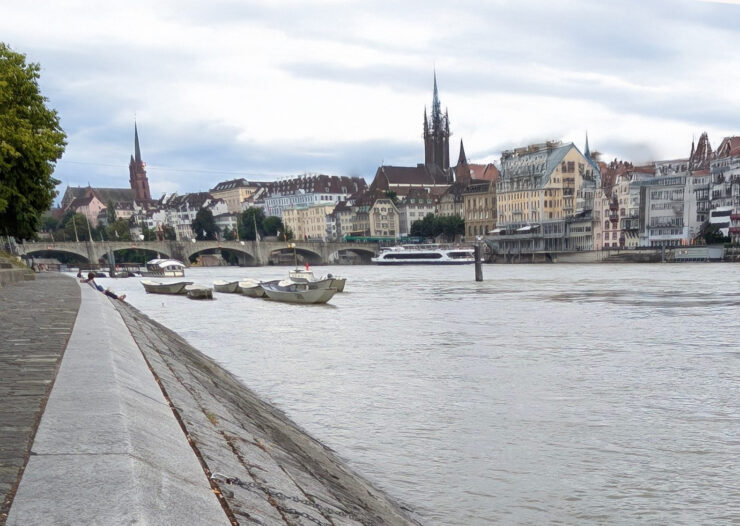I came to Basel to swim the Rhine.
Swimming the busy Rhine River in downtown Basel has been an eccentric local indulgence for nearly 25 years, undertaken enthusiastically by locals and curious guests. On climate-changed Swiss summer days the waters around the Mittlere Brücke, the iconic bridge linking Grossbasel’s old town with the grittier Kleinbasel on the other side of the river, can churn with swimmers.
Or floaters, in many cases. Some of the folks in the water cling to inflated bags in the shape of fish loaded with their clothes, shoes, and cell phones. (Unless they are holding their phones on sticks to capture the action for Instagram and so forth. You can find a lot of these online.)
Swimming the Rhine Close to the Shore
Basel’s Rhine swimmers float close to river banks, usually from one stone dock or patch of sand along the water to the next. They cover perhaps a kilometer, sometimes more, but stopping before they drift into the hectic, dangerous waters of the port. Buoys that tell boats not to come any closer to shore tell swimmers not to go any closer to the boats.
At some places along the swimming route chains drape from stone walls, providing handholds to climb out. Several ramps provide easy walk-out access.
Afterward the swimmers rinse the river away at dockside showers, put on the clothes that somehow actually stayed dry during their swim, and pocket their cell phones, ditto. Then they retire to the buvettes, small cafes along the river serving snacks like fried cheese, and local beer and wine on tap. There, they bask in the sun and laugh off their little adventure.
The Rhine Was Wet
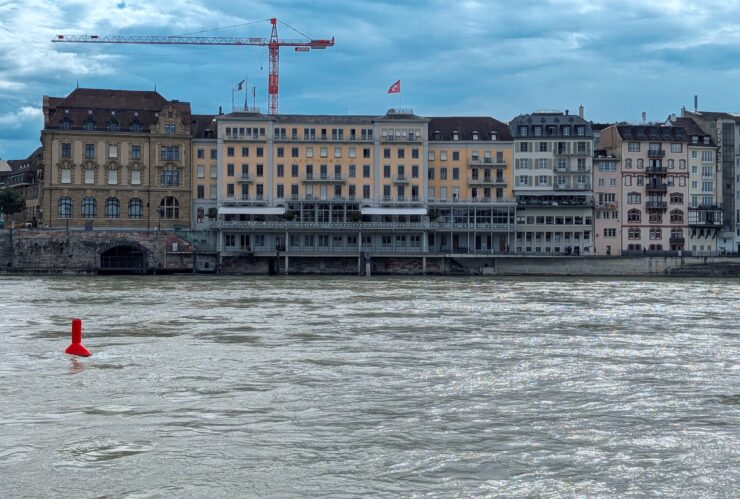
But in the weeks before our late July visit it rained heavily in the Canton of Graubünden, the Alpine region where the river is born, and throughout that region of the Alps. It rained in Basel too, hard. It felt like nickels were bouncing off my umbrella. The river was swollen, the current fierce, the water the color of aged pewter.
On the first afternoon of our visit, as I sat on my hotel’s terrace nursing a $26 Three Kings Old Fashioned, a low merchant ship called the Vespucci powered along the river toward the port, rushing under the arches of the Mittlere Brücke. By my landlubber’s eye it appeared to be moving along at 40 miles an hour.
Not a single soul was swimming the Rhine that day.
From Filth to Fun
Fifty years ago, Basel’s stretch of the Rhine was stinking with industrial bilgewater and agricultural runoff. An infamous 1986 chemical disaster turned the river the color of blood for hundreds of miles. Decades of indifference made the river strictly off-limits for recreation.
When fish vanished and even the bravest swimmers retired their goggles, locals finally took action, and they did so in the most Swiss manner: Collective action, persnickety regulation, and engineering ingenuity. Eventually, they brought the Rhine back, measurably clean enough to swim.
Headed to Basel? Read about Kunsthaus, Basel’s contemporary art museum.
More ingenuity: Basel’s own Tilo Ahmels, a designer who in 2002 invented the Wickelfisch, a colorful, waterproof, inflatable, fish-shaped bag. Fold its lip over seven times (it must be seven times precisely) and it somehow creates a watertight seal. Equal parts practical and quirky, it’s quintessentially Swiss.
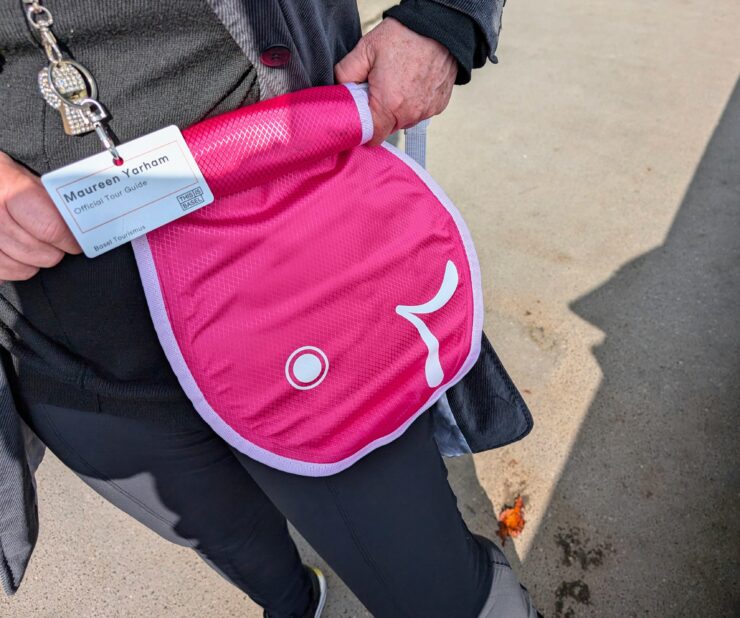
It also enabled casual urban swimming. Suddenly, people who were not athletes in Speedos could stuff their clothes into cartoon fish and float downstream without a care. Some began to swim to commute to their jobs.
Summer now sees schools of Wickelfisch bobbing along, as Baselites and visitors join the frolic. Each August, the annual Rheinschwimmen draws a crowd—some 4,000 enthusiastic swimmers on one sodden day. Over the course of a May to September season, it’s reported that over 50,000 take the plunge. The plazas near the buvettes fill with swimmers drying off in the sun.
Danger Ahead
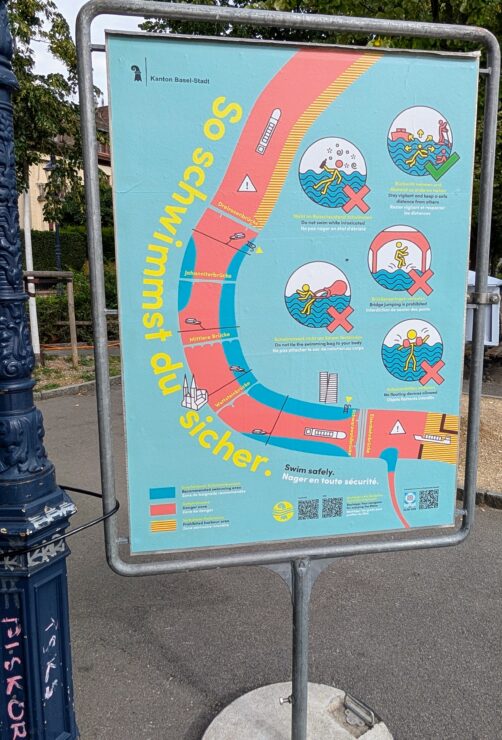
As I walked the riverside path one sunless afternoon I came across a sign the size of a hostel mattress full of instructions and warnings for Rhine swimmers: Only strong swimmers should try it. No floating vests or toys allowed. Stay close to the shore. Do not strap the bag to your body (a tour guide later told me that two people die each year on the swims, sometimes tangled in the channel buoys’ chains). Last, scan this handy QR code to see if conditions allow swimming.
So I scanned. The graphs for water level, outflow, and pollutant levels spiked like hockey sticks. Yellow triangles with exclamation marks warned me urgently. The water level was 247 meters above sea level, one meter above the danger zone. Only the water temperature, 19.6 °C (67.3°F), was within the safe range. (The official advice is not to swim if it’s under 18C (64.4F).)
I ventured down to the water to one of the places where, if July had been dry up in the Alps, I could have stepped into the water with my Wickelfisch. It was a stone platform, probably a boat launch. Ominously, a white life saver ring was strapped to a fence just behind me.
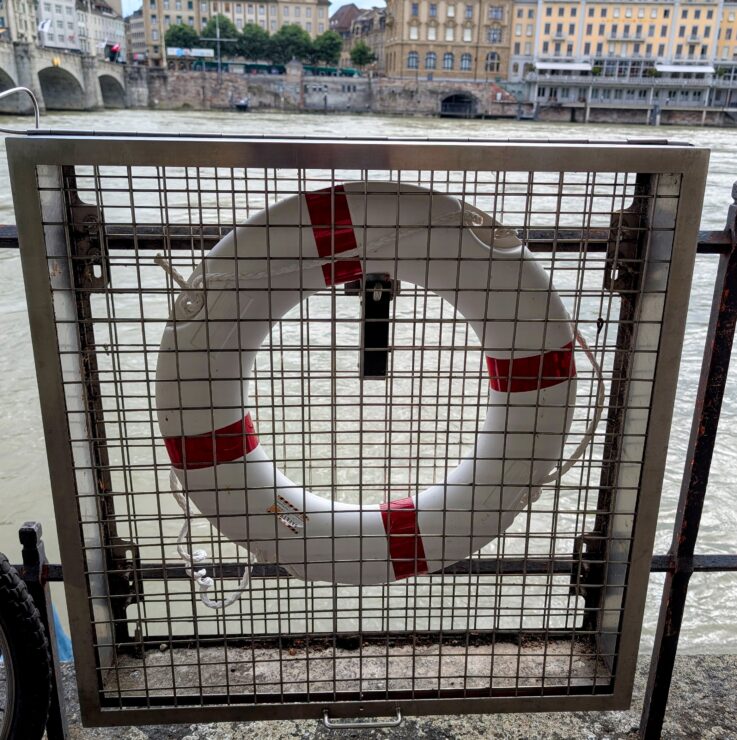
I reached into the water. It was placid and only slightly cool.
Ten feet out into the channel, the river thundered.
I retreated to a buvette and ordered a glass of a delightful Swiss white wine on tap. I sat sipping it, watching the water rush past.
One Last Try
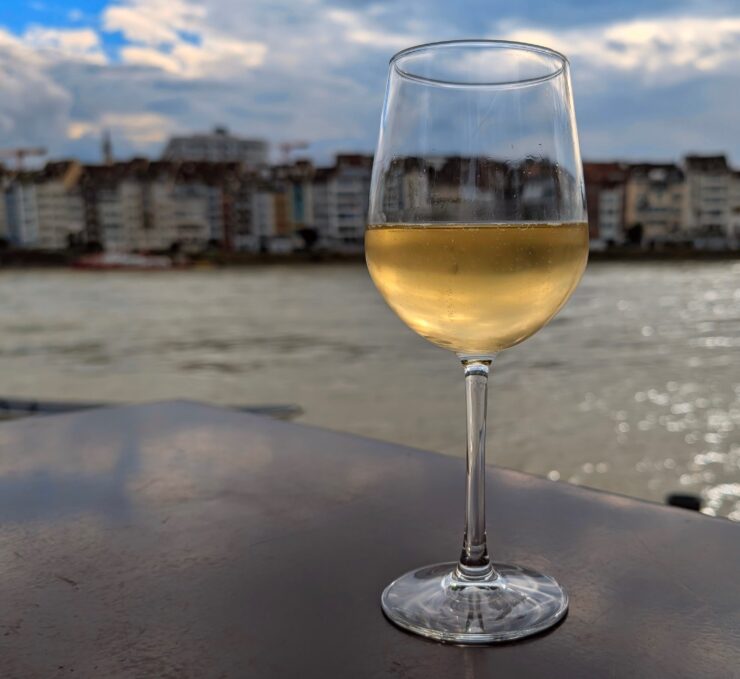
The following day was sunny, the river brighter. Still hopeful, I scanned the QR code again. The hockey sticks again spiked on the graphs, the yellow exclamation points still waving me away. The river was one meter higher.
Dozens of people huddled at the river’s edge, fully clothed and eating sandwiches. I didn’t see a swimmer. Not a single Wickelfisch.
Once again, I retreated to a buvette.
I came to Basel to swim the Rhine. Instead, I drank Swiss wine and watched the river.
If You Go
Basel is Switzerland’s arts capital, with 40 museums in its small downtown core. It also has eclectic food, including native Swiss cuisine (heavy!) and cooking influenced by neighboring Italy, Germany, and France.
- It’s walkable, bikeable, multi-lingual, very expensive, and easy to visit.
- When you stay overnight, you’ll get a BaselCard, which gives you serious discounts on attractions and free transportation. Keep it with you. We left it at our hotel and had to pay full price for our e-bikes, and it cost us $120 each for the day instead of $60.
- It’s about an hour by train from Zurich, the main international airport.
- Information: Basel Tourism
Switzerland is lovely all times of year.
- The crowds are in the Jungfrau Region (Interlaken, Lauterbrunnen, Grindelwald, Wengen, and Mürren), Zermatt and the Matterhorn, Lucerne, Zurich, and Bern. All places are less crowded in the shoulder seasons of spring and fall.
- Switzerland uses the Swiss Franc, not the Euro. When we went, the exchange rate was about $1.25 to one Swiss Franc.
- Everything is crazy expensive. Expect to pay between 25 percent and 50 percent more than what you’d pay for accommodations, restaurant meals, and attractions after adjusting for the Swiss Franc’s value.
- The trains and trolleys are, as advertised, shockingly efficient, at worst two minutes late in our experience.
- Information: Switzerland Tourism
You might also enjoy:
- Discover the Timeless Hospitality of the Nation of Georgia
- Beyond Google: Finding New Mexican Food the Old Fashioned Way
Craig Stoltz writes the Substack newsletter Eat the World.

